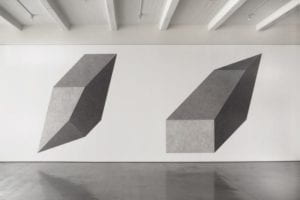I chose the Wall Drawings by Sol Lewitt because it renders me a sense of the third dimension while the image itself is not complicated and I am able to produce the image using the knowledge I already possessed. The two irregular objects have similar but different colors on each side, conveying the message of the side which is illuminated by the light and the side which is in shadows. Comparing with other images, drawing this specific image requires precise connecting of different shapes and the proper choice of color, in order to produce a 3-D sense.

I mainly wanted to copy the exact two irregular objects as long as colors on each side. Because the 3-D objects can be embodied through plane figures, I would achieve my goal by drawing figures in accordance with each side of the irregular object. Since most of the plane figures are neither rectangles nor triangles, I used a lot of vertex functions to produce irregular objects. The very first product seemed somewhat distorted because I am not sure of the side ratio but focused too much on adapting to the size of the canvas. After several adjustments to the values of the lengths of lines, they ultimately matched. Then I tried several times to adjust the color of each figure to further develop the sense of the third dimension. Though the two objects looked the same with the two in the image, it lacked creativity and the sense of interactivity. Therefore, with the help of the cheat sheet, I added some code in order to make the background color change according to the position of the mouse.
My final creation possesses the same two irregular objects as the motif but has a different color-changeable background, which provides a sense of interactivity. For this particular piece of creation, drawing in Processing is a good tool in the color-changing part but was too complicated for drawing simply the two irregular objects. If only two fixed patterns were needed, we can just use rulers and pens or illustrator to produce them within a short period. However, Processing is a good tool to produce complicated and interactive creations, which drawing on papers will never do.
Code:
void setup()
{size(600,600);
}
void draw()
{
background(255*mouseX/width, 255*mouseY/height,0);
noStroke();
beginShape();
fill(211,211,211,200);
vertex(10,400);
vertex(50,200);
vertex(130,200);
vertex(90,300);
endShape();
noStroke();
fill(105,105,105,200);
beginShape();
vertex(10,400);
vertex(90,300);
vertex(130,350);
endShape();
noStroke();
fill(190,190,190,200);
beginShape();
vertex(50,200);
vertex(120,100);
vertex(210,100);
vertex(130,200);
endShape();
fill(80,80,80,200);
noStroke();
beginShape();
vertex(130,200);
vertex(90,300);
vertex(130,350);
vertex(170,300);
vertex(210,100);
endShape();
noStroke();
fill(211);
rect(310,300,120,90);
fill(190);
beginShape();
vertex(310,300);
vertex(410,150);
vertex(490,150);
vertex(430,300);
endShape();
fill(105);
beginShape();
vertex(410,150);
vertex(490,150);
vertex(530,100);
endShape();
fill(80);
beginShape();
vertex(530,100);
vertex(490,150);
vertex(430,300);
vertex(430,390);
vertex(490,315);
endShape();
}